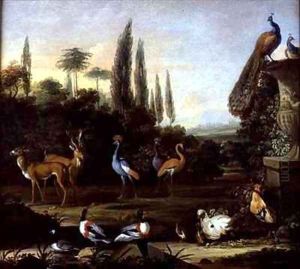Johannes Bronckhorst Paintings
Johannes Bronckhorst was a Dutch Golden Age painter, whose work primarily focused on still lifes, particularly flower pieces. Born in 1648 in the Netherlands, Bronckhorst's exact birthplace is not well-documented, which is common for many artists of that era. He is known to have been active in the artistically vibrant city of Utrecht, where he would have been exposed to the works of the great Dutch masters of the time.
Bronckhorst's career peaked during a period when Dutch still life painting was undergoing significant development. His paintings often featured intricate depictions of flowers, showcasing a variety of species in full bloom. These works were appreciated for their detail, composition, and the skillful use of color. His approach to still life was typical of the Dutch Golden Age, where such paintings were in high demand by a growing middle and upper class keen on displaying their wealth and cultural sophistication.
Although not as widely known as some of his contemporaries, such as Willem van Aelst or Jan Davidsz. de Heem, Bronckhorst's work was nonetheless valued for its contribution to the genre. He was a part of the larger movement that celebrated the beauty of the natural world through art. His paintings often included symbolic elements, common in still lifes of the time, where flowers could represent the brevity of life and the diversity of God's creation.
Johannes Bronckhorst's death is recorded in 1727. Throughout his lifetime, he would have witnessed the transformation of the Dutch Republic into one of the most prosperous and culturally rich regions in Europe. Despite the wealth of artistic talent during the Dutch Golden Age, not all artists achieved lasting fame, and Bronckhorst is one of the many whose work is only known to a smaller circle of art historians and enthusiasts. Nevertheless, his paintings are a testament to the era's fascination with the natural world and contribute to our understanding of the period's artistic achievements.
